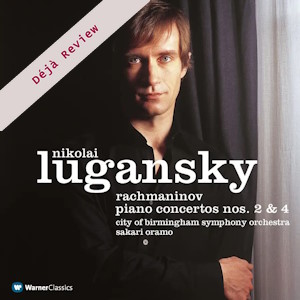
Déjà Review: this review was first published in June 2005 and the recording is still available.
Sergei Rachmaninov (1873-1943)
Piano Concerto No. 2 in C minor, Op. 18 (1900)
Piano Concerto No. 4 in G minor, Op. 40 (1925)
Nikolai Lugansky (piano)
City of Birmingham Symphony Orchestra/Sakari Oramo
rec. 2005, Symphony Hall, Birmingham, UK
Warner Classics 2564 619462 [60]
Surely not another Rachmaninov Second? Well yes. And I for one will not protest. There’s a certain reluctance among professional musicians and academics to admit that music can be great and popular. But I’ve always marvelled at this music’s skill and concentration, as much as I’m persuaded by its emotional honesty. And hearing these new performances leads me to salute this extraordinary music afresh.
These are very personal readings by Lugansky, which follow in the footsteps of his First and Third, issued earlier this year. He demands a great deal of Oramo with his rubato, which some folk may find excessive or mannered. When Rachmaninov provides slow-moving or sustained backgrounds, there is no problem. But, when orchestral detail has to bend in order to accommodate the soloist, the result is less convincing. Even when the pianist is on his own, it can be irritating to have the momentum of a left-hand accompanying ostinato disturbed on account of an indulgent right hand: the brakes are often applied in this way. Not surprisingly, there are occasions – when an idea is stated by the pianist, and then by the orchestra, or more commonly vice versa – when we get material stated both ‘straight’ and ‘bent’. But there’s no rule about consistency (or otherwise) in such matters, and it may not bother you as much as it bothers me.
In any case, this mildest of criticisms is all I could possibly level against these otherwise-ideal performances, which are impassioned, virtuosic and idiomatic. Lugansky plays with a steely clarity and accuracy: his piercing fingerwork (recalling the legendary Richter-Wislocki partnership) makes for some dramatic and incisive climaxes, abetted by the feverish excitement of Oramo’s accompaniments. Similarly, the sound is bright and detailed, rather than warm. Warmth per se comes more from within – and warmth, tenderness and delicacy are there in plenty.
Of the countless alternatives in the catalogue, I must mention the Ashkenazy-Haitink collaboration, similarly coupled, which I’ve always found especially appealing, even though collected opinion seems (almost unanimously) to be in favour of Ashkenazy’s previous recordings. Its great virtue is Ashkenazy’s discipline – not the first quality you’d look for in this music? – and the seductively beautiful playing of the Concertgebouw. Lugansky and Oramo are more visceral, more masculine, and perhaps more in line with Rachmaninov’s wishes and expectations – but not necessarily more satisfying.
Most would-be purchasers with an eye for a new recording will want either Lugansky or Hough, whose recent complete set recorded in Dallas won near-universal praise. It’s a close race, but compare the two of them in the opening bars of the Second – Lugansky expansive and exploratory; Hough much less patient, treating it as a direct line to the opening Allegro theme – and you’ll soon know which one you want!
Lugansky’s are wide-ranging performances which encompass the entire gamut of Rachmaninov’s inexhaustible emotional palette. Like the First and Third before it, they can be enthusiastically recommended.
Peter J Lawson
Buying this recording via a link below generates revenue for MWI, which helps the site remain free


















